Chat at Researchers' Night Zurich
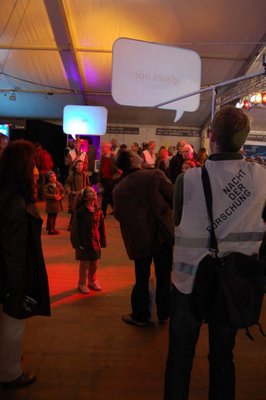
Zurich was great fun. The first time that I had so many kids using Chat. All pics on flickr.
NOME is pleased to announce are we there yet?, a group exhibition that critically examines issues of police brutality, mass incarceration, discrimination, immigration, and state surveillance. The show draws its title from a work by Kameelah Janan Rasheed, whose aphoristic text-based practice often grapples with complex societal questions. As with many of her works, are we there yet? carries multiple meanings, symbolizing both a push for equality and the darker undercurrents of state violence. The exhibition invokes Rasheed’s question to probe the spread of authoritarianism in contemporary society.
Artists: Camae Ayewa, Sadie Barnette, Aram Bartholl, Danielle Brathwaite-Shirley, James Bridle, Paolo Cirio, Cian Dayrit, Priscilla Dobler Dzul, Navine G. Dossos, Igor Grubić, Kite, Kameelah Janan Rasheed, Voluspa Jarpa, Ahmet Öğüt, Dread Scott, Myriam Zarhloul
ANNKA KULTYS GALLERY is pleased to present Greetings From Germany! (2024), a single-channel video by German artist Aram Bartholl, a poignant critique of police activities on the streets of Berlin, underscoring the potential of art to confront and illuminate complex truths. This presentation is part of Illuminated: Moving Image Perspectives, the gallery digital programme, which will take place over the course of a year, and offer unique insights into new media artists using film, video animation, as well as their latest technological explorations, including blockchain and advanced technologies such as AI.
Aram Bartholl’s, video Greetings from Germany! (2024), uses the technology of AI as a space of opportunities to explore disturbing policies around modern urban policing. The ironic title belies a serious underlying message about police activity on the streets of Berlin — a reminder that art can be a powerful tool to consider truth more fully.
For this work Bartholl chose a single image from a recording of an anti-war demonstration in Berlin where police were involved. Using this single frame, Greetings from Germany! presents six alternative realities generated by different AI video systems. The unfolding events are unsettling, playing with notions of certainty. It is difficult to know precisely what is happening as figures morph into one another. Lines are blurred between police, demonstrators and bystanders and precisely what is happening – one figure appears to dance. As the video is shot from the point of view of the audience, (reminiscent of smartphone streaming), the work gives the impression of the viewer being a witness to events unfolding. This creates a sense of immediacy, yet questions of veracity soon arise. The use of a variety of video generators shows how each of these commercial AI models give a slightly different angle to the ambiguous narrative. Shockingly, however, in the final shot, the ambiguity disappears as the viewer is confronted by a distressing clip of found footage of the incident.
This work is about holding a mirror to society, making visible aspects of public policy that might be easily overlooked or disregarded. By using one of the major tools of contemporary society – AI, Bartholl here encourages the viewer to look again, reconsider definitions of what constitutes the real, and catalyse conversations around critical issues.
What is the Ruhr area? An exciting metropolitan region centred around the major cities of Dortmund, Essen and Duisburg? Or a collection of scattered towns and villages from Alpen to Xanten? Or both? Does it consist of tranquil river landscapes along the Ruhr, Emscher and Lippe or is it hopelessly damaged by the scars of heavy industry? Ruhrpott, example of transformation, poverty zone – how can art open up, change and enrich this diverse region?
Urbane Künste Ruhr wants to find out and is launching the Grand Snail Tour in autumn, an artistic-performative journey through all 53 cities in the Ruhr region. Because this is an ambitious endeavour and Urbane Künste Ruhr has set itself the goal of getting to know local players, forming bonds and establishing sustainable networks, this is a three-year project.
Kick-off Grand Snail Tour in Xanten
Urbane Künste Ruhr is launching the Grand Snail Tour in autumn, an artistic-performative journey through all 53 cities in the Ruhr area. The kick-off event will take place on 26.9. in Xanten.
As the race to create an artificial general intelligence (AGI) accelerates, questions of surveillance are more important than ever. Is it human or machine? And how can people equip themselves with the tools and knowledge they need to navigate technological futures?
Instruments of Surveillance grounds an age-old and contentious topic in the human and the everyday. From government spooks, data-extraction and activism through to generative AI, this exhibition unravels the interface between human and machine, inviting audiences to unpack the technologies that people use to surveil and their role in it.
Interact with a robotic commission by Louis-Philippe Demers. See an original WWII Enigma Machine, along with wiretaps and prototypes from the Australian Federal Police. Engage with commissions by Leah Heiss and Emma Luke, Kate Crawford, Aram Bartholl and Weniki Hensch among others.
This exhibition is curated by Jemimah Widdicombe (NCM) in collaboration with Dr. Tyne Sumner, current ARC DECRA fellow at the Australian National University.
Die Jahrestagung 2025 des SFB Intervenierende Künste findet statt am:
Freitag, 9. Mai 2025, 18 bis 22 Uhr und
Samstag, 10. Mai 2025, 10 bis 20 Uhr
Sie wird organisiert von der Arbeitsgruppe „Digitaler Aktivismus“ in Kooperation mit dem HAU Hebbel am Ufer.
Programm und weitere Informationen folgen.
Zeit & Ort
09.05.2025 – 10.05.2025
HAU 2, Hallesches Ufer 34, 10963 Berlin
This Saturday (11AM-5PM) we welcome Ides Of March, a grass-roots initiative organised by local citizens seeking to raise awareness around the topic of police brutality, in collaboration with KOP Berlin, a campaign for victims of racist police violence.
On March 15th, 1997, the first observation of the international day against police brutality took place in Montreal, Canada, initiated by the Collective Opposed of Police Brutality as a response to extremely violent and racist behaviours perpetrated by authorities. We take this opportunity to explore the topic of police brutality on a local and global level, as well as interlinked practices of racial profiling. With the backdrop of weekly, if not daily, reports of police violence against protestors in Berlin, the topic is more relevant than ever. The event comprises an installation curated by Ides Of March with guest contributors including Aram Bartholl, which is open throughout the event, plus a panel talk from 2:30-3:30PM and free toolkits. The panel talk is titled Beyond The Shields: The Contemporary Function Of Police Brutality In Our Society and will take place in English. The speakers are Ignacio Rosaslanda (Unpublished), Gonca Sağlam (KOP Berlin), reporter Julian Daum and moderator Rahim Chattaika.
KUNSTSURFER is a browser-based art space. It runs on an add-on that recognises advertisements and replaces them with digital exhibitions. KUNSTSURFER brings art into your daily browsing. It plays with the ways online advertisements look and work. It takes over commercial space to host experimental, digital site-specific curatorial and artistic projects.
FACTS, FAKES AND FEARS
Desinformationen im Zeitalter von künstlicher Intelligenz und Sozialen Medien
Die Auftaktausstellung zum Jahresprogramm von EIGENHEIM Weimar 2025
Ort: EIGENHEIM Weimar, Gärtnerhaus im Weimarhallenpark, Asbachstraße 1, 99423 Weimar
Eröffnung: 21.02.2025 um 19 Uhr
Dauer: 22.02. – 29.03.2025
teilnehmende Künstler*innen: Gökçen Dilek Acay, Benedikt Braun, Cosima Göpfert, Frankfurter Hauptschule, Alison Jackson, Tea Mäkipää, Tommy Neuwirth, Sarah Oh-Mock, Julian Palacz, Michal Schmidt, Julia Scorna, Marcus Sternbauer, Anke Stiller, Addie Wagenknecht, Moritz Wehrmann, Lars Wild, The Yes Man, 庄睿哲 Ruizhe Zhuang
After the success of the Athenian version of Total Screen Time, and after ‘Brainrot’ was voted last year’s word of the year, we are back in Berlin! No,no we are so,so back! Meanwhile, everyone seems to be obsessed with their screen time. Some are trying to downsize it, some are accepting their ‘terminally online’ identity, some perceive it as a competition, and some—as always, simply don’t care.
Enough with the heavy! We invited thirty artists to present digital works through their own personal devices, extending an intimate invitation for audiences to peer through the artist’s screen—a portal into their unique, brainrot-filled worlds. From personal and collective imagery to camp, critical takes on surveillance, viral memes, and wholesome escapism—artworks from every corner of the digital psyche are on display. This one night exhibition is about connecting, sharing in the joy of deep-frying our brains, rather than in isolation. And we think THAT’S HOT!
Curated by:
Aram Bartholl & Socrates Stamatatos
Participating artists:
!Mediengruppe Bitnik with Selena Savić & Gordan Savičić, Afroditi Panagiotakou & Manolis Manousakis, Aleksandra Domanović, Clusterduck, Constant Dullaart, Cory Arcangel, Danielle Brathwaite-Shirley, Darsha Hewitt, Dirk Paesmans, Esben Holk, Evan Roth, Igor Štromajer, Ingrid Hideki, Ipek Burçak, Jan Berger, Joan Heemskerk, Joana Moll, Joanna Bacas, Jonas Lund, Katerina Baxevani, Kathrin Hunze, Marsunev, Miltos Kontogiannis, Nadja Buttendorf, Nestor Siré, Niko Princen, Nora Al-Badri, Olaf Val, Ria Schöneberger, Theo Trianfyllidis
Total Screen Time is a one night group exhibition on phones! All participating artists will bring a phone with their artwork on it, which will be mounted on the walls of the exhibition space. The idea behind the show is that the audience gets to peep through the hole of the artist’s phones immersing into their artworks. LET’S BRAINROT TOGETHER! 🧠 In a collective and liberating moment we asked all artists and visitors to share their daily phone screen time during the opening. WE ARE ALL GETTING EXPOSED LOL 🎀

Zurich was great fun. The first time that I had so many kids using Chat. All pics on flickr.
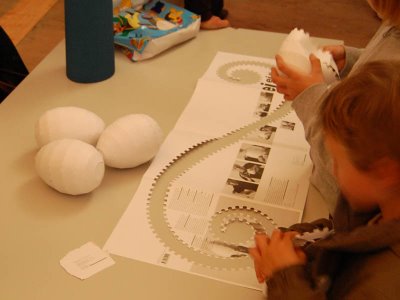
A beautiful DIY paper craft egg model called “ei ei ei” I saw during the Researchers’ Night Zurich last week. From a perforated sheet of paper you could easily ‘click’ a perfect egg. Nice! More info (german) and a PDF download here.
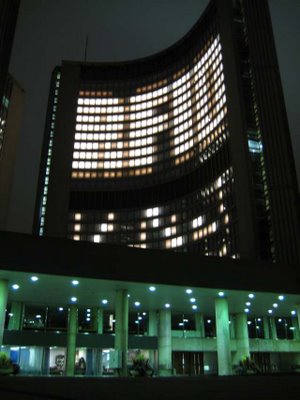
A new version of the famous Blinkenlights called Stereoscope is about to get launched on city hall Toronto the next days. New technology for the ‘screen’ has been developed and an application for the iPhone is already available.
I am very curious for the interaction factor. 🙂
Good luck to Tim and the team!
All news on blinkenlights.net/blog
Pic of the first test run yesterday. Looks great!
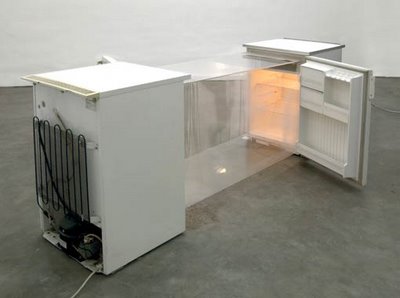
I love the works of Michel de Broin! Very good stuff!
http://www.micheldebroin.org
thx for the link Jerry!
Great Encounter
Two refrigerators, Plexiglas shape
By definition a refrigerator stands alone in its corner and, withdrawn from the world, it controls its atmosphere and protects its contents. Its door must be kept closed, otherwise it looses its cool. This withdrawal explains the isolation of refrigerators.
Is it possible to envision the encounter between two refrigerators? In this installation, two solitudes unite through a canal connecting their inside worlds. This unusual encounter produces a mist on the surface that binds them together.
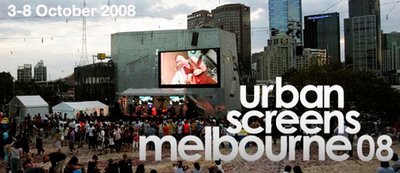
My good friend Mirjam is about to open the Urban Screens Melbourne festival/conference on the upcoming weekend. Looks like a promising program (Saskia Sassen etc…). If you are Downunder go there and take a look.
www.urbanscreens08.net
**********************************************************************
Urban Sreens Melbourne 2008
Public Multimedia Program: 3.-8. October 2008
Conference “Mobile Publics”: 3.-5. October 2008
http://www.urbanscreens08.net
**********************************************************************
As part of USM08, Melbourne’s central city square comes alive with an
Extensive outdoor exhibition that explores the diverse local infrastructure
of urban screens, utilized to create the atmosphere of a lively modern
public space.
USM08: Connected Communities is a free public multimedia exhibition
exploring the influence of digital moving images in public spaces utilizing
the infrastructure of Federation Square and temporary LED screens, in
selected regional Australian cities.
The exhibition is a six-day program that experiments with the programming
of a wide range of cultural content, suitable for urban screens. USM08
presents film screenings, an artistic short film program, interactive art,
audiovisual performances, projections, VJ sets, live streamings and public
remote talks.
The international program includes e.g. specific artistic night an morning
screenings, considering the issue of light and sound pollution, a special
local indigenous program, futuristic films such as Spielberg’s Minority
Report or visual thought provoking films such as Koyaanisqatsi as well as
interactive screen-based projects including Falling Times – a participatory,
news translation machine based on the universal language of signs; Seed –
whereby people receive a ‘seed’ via their mobile phone that they can grow
into a tree on the big screen; and MobiSpray – an application that allow
visitors to digitally spray paint the architectural façade, StalkShow – a
screen backback performance, dealing with the threat of insecurity and
isolation in public space or Reflections, a real-time documentary about our
emotional connection to water and urban screens experience.
USM08 has invited Melbourne-based festivals and their creative communities
to share the platform of USM08 to explore ways of inspiring the city to
modernise the use of urban screens. Selected highlights from partner events
such as the New York based Streaming Museum, Art at the Heart from Alice
Springs and Blinkenlights Stereoscope from Toronto will be broadcast live as
part of the Joint Broadcasting program.
All the info you need is on: http://www.urbanscreens08.net
contact: info@urbanscreens.net
USM08 is initiated by the International Urban Screen Association and hosted
by Fed Square Pty Ltd. The multimedia program is produced with the
assistance of the Australian Government through the Australia Council for
the Arts, its arts funding and advisory body, the conference developed in
cooperation with Melbourne University.
_______________________________________
URBAN SCREENS MELBOURNE 08
www.urbanscreens08.net
Mirjam Struppek
Artistic Director
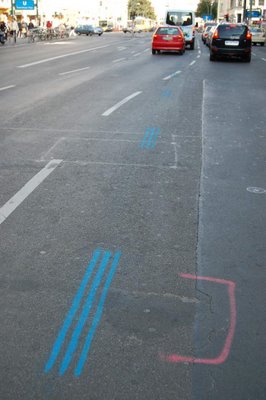
(Hmm… is this an adidas street art viral?
No, fortunately not. The three stripes which behave against all traffic street signage mark out the track for the Berlin Marathon on the upcoming weekend? How about teaming up for an early little marathon during Friday afternoon traffic rush hour? 😉 Found on Torstr/Rosenthaler Platz, Berlin)
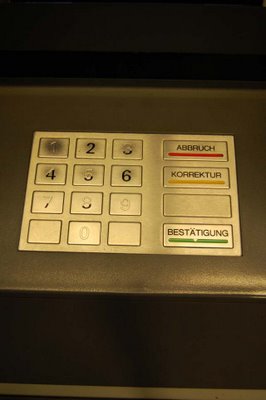
( Pin code input pad on a Deutsche Bank ATM in Berlin Prenzlauerberg.)
Hmm … isn’t that strange? It seams like everybody has a one, nine or zero in his/her four digit pin code and very few people a six or a two. Do banks have any special algorithms on generating pin codes which are simple to learn by heart? Or do we have a security issue here? Yes, true my code does not contain two, four or six. Am I in trouble now … 😉
![]()
Thanks to Theo Honohan who did write an interesting essay on my latest project “Friends“.
Aram Bartholl’s workshop Friends actualizes the processes of abstraction and distancing which are involved in the construction of contemporary social networking websites. By turning these immaterial processes into physical action and representations, the work offers a critical model of current software practice on the web.
Under the general name of Web 2.0, social networking sites provide various facilities for publishing content on the web. In the case of Flickr, the content is images; in the case of Delicious, bookmarks; Last.fm, music playlists; Facebook and myspace, general personal information. The material published on these sites is often not particularly interesting to a general viewer. Its value consists primarily in the availability of information to friends. The ability to explicitly create links of friendship between users is therefore the central feature of these sites, and the feature from which the name “Social Networking” is derived.
Bartholl’s work, which could have been titled Friends?, calls into question the value and meaning of these explicit declarations of friendship. For one thing, the mechanical nature of the process gives it a simplistic quality. Two people are either friends or they are not, according to the system. This binary coding of relationships leaves no room for gradations of familiarity from intimacy to acquaintance. This initial observation is enriched by the level of detail into which the piece goes in representing the internal abstractions of a site such as Facebook. Each level of abstraction can be seen as a distancing from reality and the site of a possible slippage between image and actuality.
The process of creating a personal profile in the system begins with a digital photograph. This image of the user is transformed digitally into a black and white stencil. Affixing a printout of the stencil to a rubber stamp, the user cuts out the white areas to create a reusable stamp of their own image. In creating a reusable stamp, the work captures the infinitely reproduceable nature of a digital image. The image can appear over and over within the “site”, rather than existing just as a single original.
The creation of a profile continues with the preparation of a blank booklet for use as a register of friends. The booklet gains structure entirely through a series of rubber stamps which mimic the process of formatting a blank computer database. Data slots are created for name, email address and website, and a further grid of spaces is prepared to hold references to the user’s details on other social networking sites. The process of registering friends involves stamping, carbon-paper transfers, and the gluing of pre-prepared adhesive stamps into the “data slots”. The complexity of this process parallels the degree of indirection and formality involved in the software behind a social networking site, if not the experience of creating friends on Facebook. Bartholl, by calling attention to this complexity, illustrates the degree to which the information we share fits into an elaborate structure.
The process of adding friends to one’s personal profile is a reciprocal one; each of you ends up with a new page in the booklet showing the details of your new friend. The piece has another component, however, a central volume which includes a page for each user which records their friends (affixed as stamps) and pending friend requests (unglued stamps are held in a plastic pouch.) The analogy here is with a central database on a system such as Facebook. The whole graph of relationships is held in one place, rather than being stored in private, personall relations between profiles/booklets. This central volume is of course the way social networking systems are actually implemented, while the “peer-to-peer” architecture of the booklets, while offering potential advantages in security and privacy, has not been pursued (except, to a degree, in the case of Skype.)
The presence of a central database is a reminder of the industrial scale and automation of the process. Bartholls’ work problematizes the mass production of social contacts. While the concrete formal techniques of the workshop (sheets of repeated portraits) evoke images of an artistic practice such as that of Andy Warhol’s “Factory”, the abstract structure revealed by the development of a profile and network of friends shows the potentially dehumanizing nature of social networks. The choice of black and white for all representations produces an impression of direct simplicity but also unyielding control. The idea of a computerized social network, in the end, is a formalism, while social relationships are blurry, vital and inevitably exceed the terms of any fixed representation.
23 September 2008
I was not allowed to embed this nice video but fortunately I know how to write in hyper text markup language. When you click with your mouse pointer at the following uniform resource locator adress starting with hypertext transfer protocol your web browser (A web browser is a software application which enables a user to display and interact with text, images, videos, music and other information typically located on a Web page at a website on the World Wide Web or a local area network.) will hyperlink you automatically to the movie. Isn’t that great? (Next time I ll explain what YouTube is.)
http://de.youtube.com/watch?v=Ovvk7T8QUIU
Sorry for waisting your time. 😉